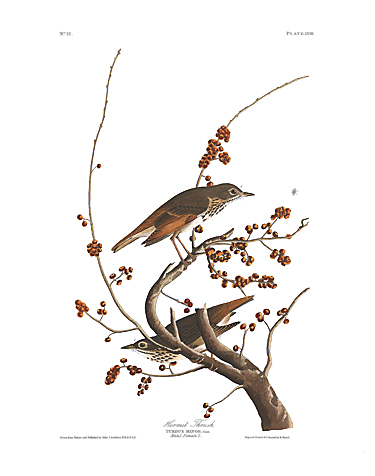|
Havell Name
Hermit Thrush Common Name Hermit Thrush Havell Plate No. 058 Paper Size 39" x 28" Image Size 14" x 20" Price $ 600 |
||||
|
Ornithological Biography This, kind reader, is another constant resident in the Southern States, more especially those of Mississippi and Louisiana, where it abounds during the winter months, and is found in considerable numbers during spring and summer. In the lower parts of Kentucky, Indiana and Tennessee, it is also observed during spring and summer; but it becomes scarcer as you advance towards the Middle Districts, where a few are occasionally seen about the low woodlands of the Atlantic shores.
Except during winter, this Thrush prefers the darkest, most swampy, and most secluded cane-brakes along the margins of the Mississippi, where it breeds and spends the summer, retiring to higher lands during the period when the alluvial grounds are covered with the water which, during freshets, generally inundates these low cane-brakes and swampy retreats. The flight of the Hermit Thrush is performed low over the ground, and in a gliding manner, as the bird shifts from one place to another at a short distance. In this respect, it differs greatly from its relative, my great favourite, the Wood Thrush, the flight of which is more protracted, and is performed at a greater elevation. This Thrush is most frequently seen on the ground, where it hops with the same movements employed by the well-known little Red-breast of Europe, in other words, before it hops its breast almost comes in contact with the ground, the tail is a little raised, the wings droop, and after hopping, it runs a few steps, erects its head, and looks around. All the nests of the Hermit Thrush which I have found were in every instance placed lower on the branches of trees than those of the Wood Thrush, seldom above seven or eight feet from the ground, and sometimes so low that I could easily look into them. These nests were fixed to a horizontal bough, but were not saddled upon it so deeply, as those of the Wood Thrush are. They were smaller, and had no mud or plaster of any kind, but were extremely compact, the outer parts being formed of coarse dry weeds, and here and there a withered leaf, the interior composed of a long delicate kind of grass, which is found growing along the edges of cane-brakes. This grass is arranged in a circular manner, to the whole extent of its length, and waives the inner part of the nest of this bird a remarkable appearance of neatness and finish. The female lays from four to six eggs, of a light blue colour, sprinkled with dark dots towards the large end. The first set are laid early in April, the second about the middle of June; for, in Lower Louisiana, this species rears two broods in the year. The female is much attached to her nest, and glides off silently from it when closely approached, not, however, unless she thinks herself or her nest observed. The young run after the parents, on the ground, for several days after they leave the nest. As soon as the waters of the Mississippi become so swelled as to overflow the banks, the Hermit Thrush retires to the nearest hills, and mixes with many other birds, amongst which the Wood Thrush is preeminent. The former is, however, easily recognised at once, by its single plaintive note, heard from the boughs of low trees, on the berries of which it feeds. In fact, its food is altogether composed of different fruits and berries which are at all seasons abundant in our woods. In the Middle Districts the Hermit Thrush is only observed during a few weeks in the spring and again in autumn. It arrives in the States of New Jersey and New York between the end of April and the middle of May, generally in a desultory manner, and, throwing itself into the depths of the forests, there spends the summer months, frequenting the lowest and most shady thickets. Its song is sometimes agreeable. |
|||||
|
|
|||||


| Home | Gallery | Audubon Biography | About Edition | Testimonials | Authorized Dealers | Links | Contact Us |

© Copyright 2007-2025 Zebra Publishing, LLC. | All Rights Reserved Terms of Use
Powered by Fusedog Media Group
